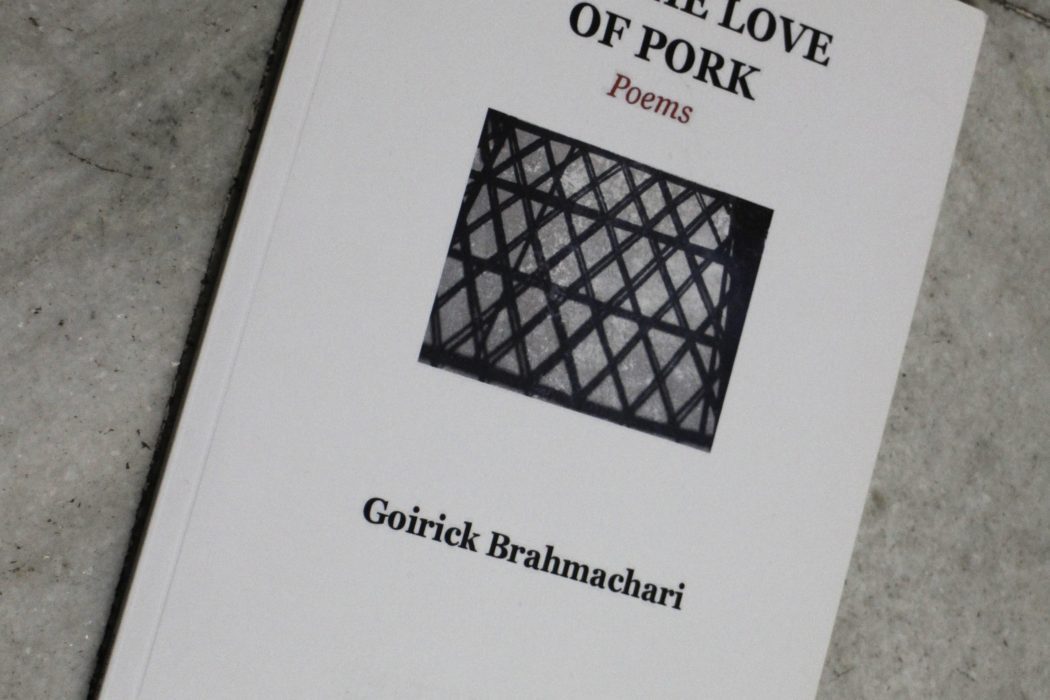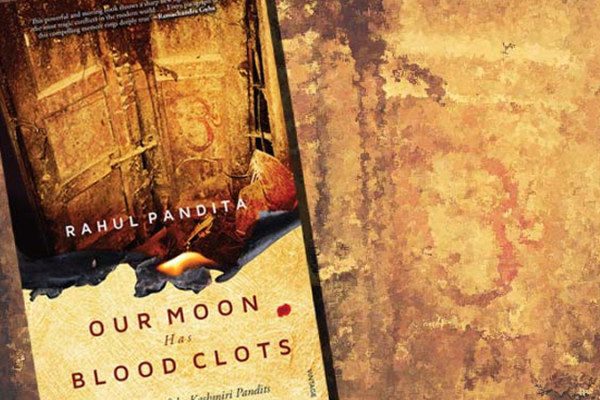Brahmachari’s nostalgia is laced with tensed remembrances of a mesmerising landscape cut into many pieces by political borders, drawn and reinforced by the gory virtue of ethnic and communal violence, says Aritra Mukherjee as he reviews Goirick Brahmachari’s 'For the Love of Pork'.
Goirick Brahmachari’s debut poetry volume, For the Love of Pork, is an inebriating journey from the misty Himalayan mountains of Assam and Meghalaya to the crisscrossing flyovers, malls, bars and by-lanes of insomniac Gurgaon and Delhi. This Kerouac-ian road trip is neatly sub-divided into two sections, namely, “Home” and “Away”.Although the first fourteen poems that open the collection convey the poet’s deep emotional ties with Silchar, his hometown, they do not fall into the conventional trap of over-romanticising a lost home.
On the contrary, Brahmachari’s nostalgia is laced with tensed remembrances of a mesmerising landscape cut into many pieces by political borders, drawn and reinforced by the gory virtue of ethnic and communal violence. Consequently, home as a utopian childhood space, shielded by a parental cocoon from the disaffecting reach of unsavoury socio-political realities, is an idealized dream that is never translated into tangible experience. Perhaps, from this angst of a despairing search for an ideal home emerges a poem like “Borders we live with”. Here, the poet’s bewildered sense of homelessness goads him into making such stark observations:
Meghalaya, where I cannot make a home
Assam, where I am told, I am not from
Then, where is home?
Although borders and ethno-religious frictions are a presence to be reckoned with, Brahmachari deftly weaves a portrait of life that often overflows these artificial segregations. In “Language Lessons at Saturday bazar”, the reader is presented with an amiable picture of people from various ethnic origins conversing in the same Sylheti tongue. Even though Sylhet is in Bangladesh, the dialect nevertheless forms a trans-international bridge, joining various communities irrespective of their religious and ethnic identities. Similarly, in “Another supper at Lad Rymbai”, the poet depicts a heterogeneous congregation of “[J]unkies, prostitutes, businessmen, and middle class gentlemen with their families”, eating their supper together at the hotels lining NH 44, which runs through the Meghalayan coal town of Lad Rymbai. Brahmachari’s vision of communal and cultural tolerance, respect and unity reaches its apotheosis when, contemplating on the ever merging, timeless waves of the Brahmaputra in “Of rivers and river-islands”, he says,
“If only we could love our mutual cultures, without forgetting our own… and forget… a bad history, while respecting identities and showing middle finger to the politics of divide, we too could be rivers.”
The following thirty one poems that constitute the section appropriately titled, “Away”, take us to the paradoxes that form the flesh and blood, the concrete and sludge of the megacity of Delhi.
Far from the meandering Brahmaputra and Kushiara, from the valley of Sylhet and the Meghalayan mountains, the poet scissors through the glitzy veneer of modernised, globalised, progressive Delhi, only to release the sigh trapped in the seething soul of a listless, yet sleepless, Dilli.
In a walk, almost reminiscent of Prufrock’s wanderings through the city of London, Brahmachari takes us down “a lane where I [he] once strolled across my [his] lonesome, tea-in-earthen-cup evenings.” We see visions of love:
that follows strangers’ hands in local
bars on chemical nights
only to be forgotten when the
morning comes.
(First Northern Summer)
In the lonely nocturnal wasteland of neighbourhoods like VasantVihar, we witness a “weird mishmash/… [of] Manipuris and Nagas, Punjabis and Jats, Africans and Russians”, pulled together, held together by the uniting “necessity of junk and sex”, by the need, as Eliot would say, for an “awful daring of a moment’s surrender”. Brahmachari’s mature sensitivity, his awareness of the privileges he shares with others of his class, renders him incapable of sparing himself from being the subject of satirical observations on social inequalities. Perhaps, the social irony reaches its climactic point with the sharply telling and strongly moving juxtaposition of the following images of stark scarcity and uncontainable superfluity:
As those kids dance and rejoice over the filth the city got rid of, their mothers
sort plastic waste with their hands.
We usually clean our hands with lemon on our dinner plates after meals.
(Of landfills and lime)
Images of food and time are motifs that recur throughout the volume. The victual leitmotif, in particular, is associated with memories of home. The Assamese dishes of “Kesaaamordail”, “Aloopitika”, and “Masortenga” reminds Yogender, a cook in Delhi’s Sankardev Bhawan, and probably also the poet himself, of their individual homes in Assam. Living far away from their beloved cities and hamlets, the fond memories of over-lapping cuisines propel the “folks from the North East” to shed their respective pretensions to “ethnic superiority” and “… agree/ with each other”. Again, in the poem “Riddles of a Thali” food emerges as a symbol and site of small, transgressive acts of youthful adventure. Here, “[t]hreeJat boys taste Naga thali” in “a damp basement” eatery at Humayunpur, South Delhi. Traditionally, Jats do not consume pork or beef, but these three liberal youngsters, probably in an adventurous mood to explore and discover the “riddles” of a plateful of another gastronomical culture, willingly partake of a pork dish prepared in the Naga style with the extremely spicy “Raja mirchas”, also known as bhutjholakias. While they enjoy their food, even with streaming eyes, the anonymous “owner lady” takes the opportunity of relishing a moment of pride in her Naga culture, as she mildly mocks the trio saying, “‘Boil (-ed vegetables)/ …will fight those Raja mirchas.’”
Brahmachari embodies the movement of time through the transforming facets of a city or town. Be it the supplanting of the small “Silcoorie’sShingara house” with “the pizzas and the burgers of Premtala” and the much favoured “Momo” of “Jhalupara”, or the installation of “new street lights” on the erstwhile “dark pavements” of Silchar, it is always the temporal flow that is thus depicted through such apparently prosaic images of cultural and economic change.Interestingly, Brahmachari’s poems also register the current urban trend of night-long chats with strangers over social networking sites, as well as the propensity to cathartically ramble on about a day of one’s life in blog posts.
Through such contemporary social phenomena, the poet smoothly delineates the central contradiction symptomatic of modern metropolitan life. While on the one hand, in an attempt to dispel the looming feeling of isolation, we often addictively jack ourselves to a virtual life of connectedness; on the other hand, a non-committal attitude, coupled with the ever increasing demand for professional competence, incapacitates us from forming and nurturing any meaningful, long-term relationship based on shared, real experiences. In such a scenario, Brahmachari, representing the malaise specific to our browsing and scrolling age, suffers from frequent bouts of nostalgia. A time spent in the intimate company of friends from school, college and work chronically haunts him as an acute reminder of his present loneliness.
Brahmachari’s readers would inevitably realize that the poetic pieces are deeply embedded in his political consciousness. The semi-covert references range from the 2014 Israel-Gaza conflict, to the 2014 Trilokpuri communal riots in Delhi, and the HokKolorob students’ protest movement at Jadavpur University, Kolkata. In the light of the State sanctioned violence that takes place “in Chhattisgarh, / in Northeast and Kashmir”, the poet bluntly critiques the glamorous pageantry and extravagance of Republic Day celebrations, by fittingly citing the title of Arundhati Roy’s 2011 collection of three essays called, Broken Republic. Furthermore, Brahmachari’s debut volume is a tribute to not only music, but also the literary legacy of the Beat Generation.
While jazz, blues, and the poetry of the Beats provide him with a counter-cultural mode of subversive self-expression; the ragas, thumris, khayals and taranas of the Indian Classical music not only liberate him from the clutches of everything mundane, but also elevate his senses to a realm of transcendental beauty and love.
In the memorable poem titled, “Auliya”, the poet exquisitely describes the healing power of “Qawwali”, through which “[p]ain evolves… into an ecstasy of love”.
As a concluding comment, one cannot help noting the fact that GoirickBrahmachari’s poetic compositions, particularly the prose poems, expose, almost like Charles Baudelaire’s seamy underbelly of nineteenth century Paris- the bitter spleen of the cities like Delhi and Silchar.
The volume closes with the poem “Nausea”, where the poet, knowingly or unknowingly, echoes the Baudelariean insistence on the need to remain forever intoxicated, when he ceases his drunken chanting with the following lines:
Drunk be forever this poem
Drunk be us.


